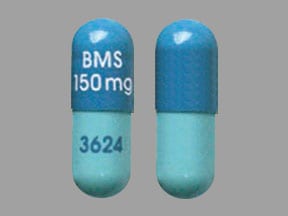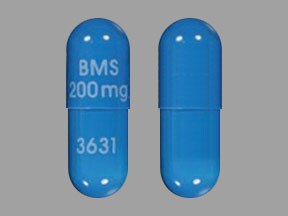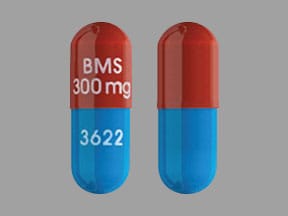What is Reyataz?
Reyataz is a prescription HIV-1 (Human Immunodeficiency Virus-type 1) medicine that is used with other antiretroviral medicines to treat HIV-1 infection in adults and children 3 months of age and older and who weigh at least 11 pounds (5 kg). HIV-1 is the virus that causes AIDS (Acquired Immunodeficiency Syndrome).
Reyataz should not be used in children younger than 3 months of age.
When used with other antiretroviral medicines to treat HIV-1 infection, Reyataz may help:
- reduce the amount of HIV-1 in your blood. This is called “viral load”.
- increase the number of CD4+ (T) cells in your blood that help fight off other infections.
Reducing the amount of HIV-1 and increasing the CD4+ (T) cells in your blood may help improve your immune system. This may reduce your risk of death or getting infections that can happen when your immune system is weak (opportunistic infections).
Reyataz does not cure HIV-1 infection or AIDS. You must keep taking HIV-1 medicines to control HIV-1 infection and decrease HIV-related illnesses.
What is the most important information I should know about Reyataz?
Ask your healthcare provider or pharmacist about medicines that should not be taken with Reyataz. For more information, see “Who should not take Reyataz?” and “What should I tell my healthcare provider before taking Reyataz?”
Who should not take Reyataz?
Do not take Reyataz if you:
- are allergic to atazanavir or any of the ingredients in Reyataz. See the end of this leaflet for a complete list of ingredients in Reyataz.
- are taking any of the following medicines. Taking Reyataz with these medicines may affect how Reyataz works. Reyataz may cause serious life-threatening side effects or death when used with these medicines:
- alfuzosin (Uroxatral)
- cisapride (Propulsid)
- elbasvir/grazoprevir (Zepatier)
- ergot medicines including:
- ergotamine tartrate (Cafergot, Migergot, Ergomar, Ergostat, Medihaler, Ergotamine, Wigraine, Wigrettes)
- dihydroergotamine mesylate (D.H.E. 45, Migranal)
- methylergonovine (Methergine)
- glecaprevir/pibrentasvir (Mavyret)
- indinavir (Crixivan)
- irinotecan (Camptosar)
- lurasidone (Latuda) if Reyataz is used with ritonavir (Norvir)
- lovastatin (Advicor, Altoprev, Mevacor)
- midazolam (Versed), when taken by mouth for sedation
- nevirapine (Viramune, Viramune XR)
- pimozide (Orap)
- rifampin (Rifadin, Rifamate, Rifater, Rimactane)
- sildenafil (Revatio), when used for the treatment of pulmonary arterial hypertension
- simvastatin (Simcor, Vytorin, Zocor)
- St. John’s wort (Hypericum perforatum)
- triazolam (Halcion)
Serious problems can happen if you or your child takes any of the medicines listed above with Reyataz.
What should I tell my healthcare provider before taking Reyataz?
Before taking Reyataz, tell your healthcare provider if you:
- have heart problems
- have liver problems, including hepatitis B or C virus infection
- have phenylketonuria (PKU). Reyataz oral powder contains phenylalanine as part of the artificial sweetener aspartame. The artificial sweetener can be harmful to people with PKU.
- are receiving dialysis treatment
- have diabetes
- have hemophilia
- have any other medical conditions
- are pregnant or plan to become pregnant. Talk to your healthcare provider about taking Reyataz during your pregnancy or if you are planning to become pregnant while you are taking Reyataz.
- Hormonal forms of birth control, such as injections, vaginal rings or implants, contraceptive patch, and some birth control pills may not work during treatment with Reyataz. Talk to your healthcare provider about forms of birth control that may be used during treatment with Reyataz.
- Pregnancy Registry. There is a pregnancy registry for women who take antiretroviral medicines during pregnancy. The purpose of this registry is to collect information about the health of you and your baby. Talk to your healthcare provider about how you can take part in this registry.
- After your baby is born, tell your healthcare provider if your baby’s skin or the white part of the eyes turns yellow.
- are breastfeeding or plan to breastfeed. Do not breastfeed if you are taking Reyataz. You should not breastfeed if you have HIV-1 because of the risk of passing HIV-1 to your baby. Reyataz can pass into your breast milk. Talk to your healthcare provider about the best way to feed your baby.
Tell your healthcare provider about all the medicines you take, including prescription and over-the-counter medicines, vitamins, and herbal supplements.
Some medicines interact with Reyataz. Keep a list of your medicines to show your healthcare provider and pharmacist. You can ask your healthcare provider or pharmacist for a list of medicines that interact with Reyataz. Do not start taking a new medicine without telling your healthcare provider. Your healthcare provider can tell you if it is safe to take Reyataz with other medicines.
How should I take Reyataz?
- Take Reyataz exactly as your healthcare provider tells you to.
- Do not change your dose or stop taking Reyataz unless your healthcare provider tells you to.
- Stay under the care of your healthcare provider during treatment with Reyataz.
- Reyataz must be used with other antiretroviral medicines.
- Take Reyataz 1 time each day.
- Reyataz comes as capsules and oral powder.
- Take Reyataz capsules and oral powder with food.
- Swallow the capsules whole. Do not open the capsules.
- Reyataz oral powder must be mixed with food or liquid. Your child’s healthcare provider will prescribe the right dose of Reyataz based on your child’s weight.
- Reyataz oral powder must be taken with ritonavir.
- If you miss a dose of Reyataz, take it as soon as you remember. Then take the next dose at your regular time. Do not take 2 doses at the same time.
- If you take too much Reyataz, call your healthcare provider or go to the nearest hospital emergency room right away.
When your supply of Reyataz starts to run low, get more from your healthcare provider or pharmacy. It is important not to run out of Reyataz. The amount of HIV-1 in your blood may increase if the medicine is stopped for even a short time. The virus may become resistant to Reyataz and harder to treat.
What are the possible side effects of Reyataz?
Reyataz can cause serious side effects, including:
- A change in the way your heart beats (heart rhythm change). Tell your healthcare provider right away if you get dizzy or lightheaded. These could be symptoms of a heart problem.
- Skin rash. Skin rash is common with Reyataz but can sometimes be severe. Skin rash usually goes away within 2 weeks without any change in treatment. Severe rash may develop in association with other symptoms which could be serious. If you develop a severe rash or a rash with any of the following symptoms, stop taking Reyataz and call your healthcare provider right away:
- general feeling of discomfort or “flu-like” symptoms
- fever
- muscle or joint aches
- red or inflamed eyes, like “pink eye” (conjunctivitis)
- blisters
- mouth sores
- swelling of your face
- painful, warm, or red lump under your skin
- Yellowing of your skin or the white part of your eyes is common with Reyataz, and is usually not harmful in adults and infants older than 3 months of age; but it could also be a symptom of a serious problem. These effects may be due to increases in bilirubin levels in your blood (bilirubin is made by the liver). Although these effects may not be damaging to your liver, skin, or eyes, tell your healthcare provider right away if your skin or the white part of your eyes turns yellow.
- Liver problems. If you have liver problems, including hepatitis B or C infection, your liver problems may get worse when you take Reyataz. Your healthcare provider will do blood tests to check your liver before you start Reyataz and during treatment. Tell your healthcare provider right away if you get any of the following symptoms:
- dark “tea-colored” urine
- your skin or the white part of your eyes turns yellow
- light colored stools
- nausea
- itching
- stomach-area pain
- Chronic kidney disease. Reyataz may affect how well your kidneys work. Your healthcare provider will do blood and urine tests to check your kidneys before you start Reyataz and during treatment.
- Kidney stones have happened in some people who take Reyataz. Tell your healthcare provider right away if you get symptoms of kidney stones which may include, pain in your low back or low stomach-area, blood in your urine, or pain when you urinate.
- Gallbladder problems have happened in some people who take Reyataz. Tell your healthcare provider right away if you get symptoms of gallbladder problems which may include:
- pain in the right or middle upper stomach area
- fever
- nausea and vomiting
- your skin or the white part of your eyes turns yellow
- Diabetes and high blood sugar (hyperglycemia) have happened or have worsened in some people who take protease inhibitor medicines like Reyataz. Some people have had to start taking medicine to treat diabetes or have had to change their diabetes medicine.
- Changes in your immune system (Immune Reconstitution Syndrome) can happen when you start taking HIV-1 medicines. Your immune system may get stronger and begin to fight infections that have been hidden in your body for a long time. Tell your healthcare provider if you start having new symptoms after starting Reyataz.
- Changes in body fat can happen in people taking HIV-1 medicines. These changes may include increased amount of fat in the upper back and neck (“buffalo hump”), breast, and around the main part of your body (trunk). Loss of fat from the legs, arms, and face may also happen. The exact cause and long-term health effects of these conditions are not known.
- Increased bleeding problems in people with hemophilia have happened when taking protease inhibitors like Reyataz.
The most common side effects of Reyataz include:
- nausea
- headache
- stomach-area pain
- vomiting
- trouble sleeping
- numbness, tingling, or burning of hands or feet
- dizziness
- muscle pain
- diarrhea
- depression
- fever
Tell your healthcare provider if you have any side effect that bothers you or that does not go away.
These are not all the possible side effects of Reyataz. For more information, ask your healthcare provider or pharmacist.
Call your doctor for medical advice about side effects. You may report side effects to FDA at 1-800-FDA-1088.
Reyataz Images
General information about the safe and effective use of Reyataz
Medicines are sometimes prescribed for purposes other than those listed in a Patient Information leaflet. Do not use Reyataz for a condition for which it was not prescribed. Do not give Reyataz to other people, even if they have the same symptoms that you have. It may harm them. If you would like more information, talk with your healthcare provider. You can ask your pharmacist or healthcare provider for information about Reyataz that is written for health professionals.
For more information, go to www.reyataz.com or call 1-800-321-1335.
How should I store Reyataz?
Reyataz capsules:
- Store Reyataz capsules at room temperature, between 68°F to 77°F (20°C to 25°C).
- Keep capsules in a tightly closed container.
Reyataz oral powder:
- Store Reyataz oral powder below 86°F (30°C).
- Store Reyataz oral powder in the original packet. Do not open until ready to use.
- After Reyataz oral powder is mixed with food or liquid it may be kept at room temperature 68°F to 86°F (20°C to 30°C) for up to 1 hour. Take Reyataz oral powder within 1 hour after mixing with food or liquid.
Keep Reyataz and all medicines out of the reach of children.
What are the ingredients in Reyataz?
Active ingredient: atazanavir sulfate
Inactive ingredients:
Reyataz capsules: crospovidone, lactose monohydrate, and magnesium stearate. The capsule shells contain gelatin, FD&C Blue No. 2, titanium dioxide, black iron oxide, red iron oxide, and yellow iron oxide. The capsules are printed with ink containing shellac, titanium dioxide, FD&C Blue No. 2, isopropyl alcohol, ammonium hydroxide, propylene glycol, n-butyl alcohol, simethicone, and dehydrated alcohol.
Reyataz oral powder: aspartame, sucrose, and orange-vanilla flavor.







